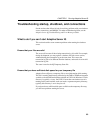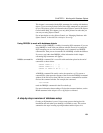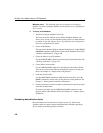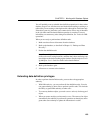
Building Your Adaptive Server IQ Databases
100
Sybase WarehouseArchitect helps you design your database.
WarehouseArchitect is a component of Sybase Warehouse Studio, an
integrated platform for designing and managing a data warehouse.
No matter what design tool you use, it is generally the database administrator
(DBA) who designs the database and defines its contents. To create an effective
design, the DBA needs to work with individuals throughout your organization
to understand how data will be used. The DBA also needs to understand the
concepts underlying IQ databases.
An Adaptive Server IQ database is a relational database that is optimized for
use as a data warehouse. As a relational database, it consists of a set of related
tables that organize the data; as a data warehouse, it provides efficient access
to very large sets of data by means of indexes.
When you create a database, you specify the structure of these tables, the types
of data allowed in them, the relationships among tables, the indexes that store
the table data, and views that control who has access to the data. Before using
the procedures in this chapter to create an IQ database, be sure you understand
the relational database and data warehousing concepts described in
Introduction to Adaptive Server IQ.
Tools for working with database objects
Adaptive Server IQ includes two utilities for working with database objects:
Sybase Central and DBISQL. In addition, Warehouse Architect can be used for
designing and creating whole data warehouses.
Using Sybase Central to work with database objects
Sybase Central is the primary tool for working with database objects on
windowing systems. You can use Sybase Central to create, modify, and delete
all kinds of database objects, including tables, procedures, views, indexes,
users and groups.
If you use the Adaptive Server IQ multiplex feature, Sybase strongly
recommends that you use Sybase Central to create and modify database
objects. In a multiplex, Sybase Central is important for creating databases and
dbspaces and for starting up and shutting down databases. DML and DDL
statements are the same for multiplex and non-multiplex Adaptive Server IQ
databases, except that the DDL must be in simplex mode. For more
information about the multiplex feature, see Adaptive Server IQ Multiplex
User’s Guide.


















